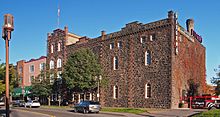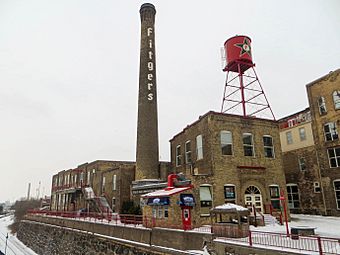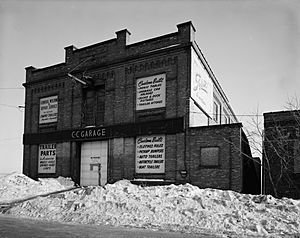Fitger's Brewing Company facts for kids

The west end of the Fitger's Brewery complex
|
|
| Location | 600 E. Superior Street, Duluth, Minnesota, United States |
|---|---|
| Coordinates | 46°47′33″N 92°5′26″W / 46.79250°N 92.09056°W |
| Opened | 1881 |
| Closed | 1972 |
| Key people | August Fitger |
| Other products | Soda, candy bars |
|
Fitger Brewing Company
|
|

Rear of the complex
|
|
| Area | 2.2 acres (0.89 ha) |
| Built | 1886–1930 |
| Architect | Francis W. Fitzpatrick, Louis Lehle, Oliver G. Traphagen, et al. |
| Architectural style | Utilitarian, Richardsonian Romanesque |
| NRHP reference No. | 84001690 |
| Added to NRHP | February 9, 1984 |
Fitger's Brewing Company was a large company in Duluth, Minnesota. It made drinks and other products from 1881 to 1972. The old buildings are still there. They stretch for about 720 feet (220 m) along the shore of Lake Superior. This area is also near East Superior Street, a main road in Duluth. Most of the ten buildings were built between 1886 and 1911. Today, the place known as Fitger's has been changed. It is now an indoor mall with stores, places to eat, a hotel, and a museum. The museum teaches about the company's history.
Fitger's Brewing Company started from a much older company in 1859. This made it the first company of its kind at Lake Superior. It was also the oldest company of its type in Minnesota that ran without stopping. This lasted until it closed in 1972. Fitger's was a big employer in the area. It made a lot of products each year. During the Prohibition Era, when certain drinks were not allowed, Fitger's stayed open. It did this by making other things like soda and candy bars.
Contents
History of Fitger's
How Fitger's Started
In 1857, there was a money problem across the country. Many early settlers left Duluth. A history book from 1910 says that in 1859, four men were left. One of them knew how to make drinks. They decided to build a company. They did not have all the right ingredients, but they still started. The men rented land on a stream that flowed into Lake Superior. This stream is still called Brewery Creek today. The first company did not make much money. But many years later, it became the Fitger Brewing Company.
In 1881, Michael Fink bought the first company. He decided to build a bigger one nearby on Superior Street. Work on the new building started on September 19, 1881. It was finished the next year. It was called Fink's Lake Superior Brewery. It had offices, rooms for workers, and its own place to sell drinks. The company sold its first products in August 1882. It was very successful from the start. They sold products far west in Aitkin, Minnesota and far east in Thunder Bay, Ontario.
On November 11, 1882, Fink hired August Fitger. August was a young expert from Germany. He had studied at a top school in Munich. Just a few months later, in April 1883, August bought half of the company for $18,000 (equivalent to $565,329 in 2022). Percy Anneke bought the other half. Percy was from Milwaukee and worked for another big company. He was a friend of August. Percy's mother was a famous activist named Mathilde Anneke. The company was then renamed A. Fitger & Co./ Lake Superior Brewery.
Staying Open During Prohibition
The company kept making products for 40 years. Then, in 1920, Prohibition began. This meant many companies had to close or change what they made. Fitger's found other things to produce. It was one of the few companies in the country that stayed open during this time. August Fitger and Percy Anneke sold their shares and moved away. Percy's son, Victor H. Anneke, took over in 1920. He wanted to keep as many workers as possible. But without selling their main product, it was hard. To keep workers, he decided to start making soft drinks and candy.
Fitger and Anneke had planned this years earlier. They thought Prohibition would not last long. The company made five-cent candy bars. Some names were The King Bee Nougat, the Flapper, and the Spark Plug. Candy sales grew for a few years. But they did not make a lot of money in the end.
Fitger's was one of the first companies to sell bottled soft drinks. They made many different flavors. Some common ones were grape, orange, and strawberry. They also tried flavors like imitation chocolate milk shake and ginger ale. They even made special bubbly drinks like Extra Dry and Silver Spray. These were very popular because of a lot of advertising.
Victor H. Anneke had a very creative idea for Silver Spray. In September 1927, he opened the Silver Spray Gym at Fitger's. He turned an old building into a boxing gym. Boxing was very popular then. The Silver Spray Gym was a fancy place for its time. The main floor was for boxing matches. The basement was for training. Victor thought the gym would help the community. It would also be good advertising for Fitger's. Many famous boxers visited the gym. This made the place well known. One famous visitor was German boxer Max Schmeling in 1928.
When Prohibition ended in 1933, people wanted Fitger's products again. From 1933 to 1936, Fitger's grew a lot. They had record sales. This success was because they kept making new products. They also found new ways to sell them. One big change was making canned products. Fitger's was one of the first companies in the U.S. to offer canned products. It was the first in the Midwest.
World War II and Later
When World War II started, Fitger's had problems again. It was hard to get supplies to keep the company going. Many things had to be reused because materials were scarce. Still, Fitger's made new products called "War Beer." These were made with fewer ingredients because supplies were limited. Also, there were not enough workers. So, women were hired to work in the factory. Before Prohibition, Minnesota had over 70 companies like Fitger's. Now, only 23 were left, and Fitger's was one of them.
In 1944, the Beerhalter family bought the company.
After the war, regular products returned. Ingredients and workers were easier to find. Fitger's also bought new equipment. People said Fitger's products were now "more pure."
In 1972, Fitger's got a letter from the State of Minnesota. There were two problems. The Minnesota Pollution Control Agency said they needed expensive new equipment to stop pollution. Also, the Minnesota Department of Transportation wanted to buy some of Fitger's land. This was for a possible new road, Interstate 35. Fitger's could not afford the new equipment. So, on September 30, 1972, it closed its doors. This ended 115 years of making products on Lake Superior.
What Fitger's Is Today
A group of business owners from Duluth bought the Fitger's buildings. They reopened the complex in December 1984. Two years later, the building of Interstate 35 hurt business. In 1994, a new company, Fitger's-on-the-Lake LLC, became the owners.
Today, Fitger's has a place that makes drinks. It also has many different stores and four restaurants. There is a museum about the company's history. You can also take a self-guided tour of some of the old buildings.
About the Buildings
The Fitger's complex has ten buildings. They were built and changed over time as needed. Most of them look practical and simple. But four buildings on Superior Street have a special style. It is called Richardsonian Romanesque. This style was popular in the late 1800s. These buildings look very big. They have round arches and rough stone walls. The stone has different colors.
One of the simple buildings was built in 1911. It was used as a garage and stable. This is where the horses and vehicles were kept. They used them to deliver the company's products.
Fitger's Legacy
The Fitger's complex was added to the National Register of Historic Places in 1984. It was listed as the Fitger Brewing Company. This was because it was important to the local area. It showed great examples of old industrial buildings. It also represented Minnesota's important history of making products.


